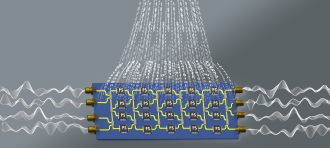Media release
From:
Scientists have achieved a breakthrough in analog computing, developing a programmable electronic circuit that harnesses the properties of high-frequency electromagnetic waves to perform complex parallel processing at light-speed.
The discovery points to a new era of computing that operates far beyond the limits of conventional digital electronics, using less energy, while performing massive calculations.
The study, Programmable Circuits for Analog Matrix Computations, has just been published in Nature Communications.
The research was led by Dr Rasool Keshavarz from the University of Technology Sydney (UTS) and Associate Professor Mohammad-Ali Miri from Rochester Institute of Technology (RIT), with co-authors Dr Kevin Zelaya (RIT) and UTS Associate Professor Negin Shariati, Founding Director of the Radio Frequency and Communication Technologies (RFCT) Lab.
“This breakthrough paves the way for next-generation analog radio frequency (RF) and microwave processors with applications in radar, advanced communications, sensors and space technologies that require real-time operations,” said Dr Keshavarz, a Senior Research Fellow, Principal System Engineer and Technical Lead at the RFCT Lab.
“We’ve bridged physics and electronics to design the first programmable microwave-integrated circuit that can execute matrix transformations, a type of mathematical operation fundamental to modern technologies,” said Associate Professor Mohammad-Ali Miri.
Conventional digital computing is limited by factors such as transistor switching, clock speed (the speed at which a digital processor executes instructions), heat generation and energy efficiency.
Analog computing, in contrast, processes information directly using continuous signals like electromagnetic waves, allowing many calculations to happen in parallel and with far less energy.
The potential applications are wide-ranging. Ultra-fast analog processors could power next-generation wireless networks, real-time radar and sensing for defence and space, advanced monitoring in mining and agriculture and new tools for industrial and scientific research.
“By establishing a platform for scalable analog signal processing, this collaboration positions UTS and its international partners at the forefront of a new computing paradigm, integrating device-level physics with system-level applications,” said Dr Keshavarz.
“This study marks the start of a broader research trajectory. Follow-up studies are already in preparation to expand the technology toward practical system-level architectures, so that computing can move beyond digital limits.”
“This novel research is a great example of taking a bold concept and turning it into reality through world-class multidisciplinary collaboration,” said Associate Professor Shariati.
“By bringing together expertise in electronics, RF engineering, physics, and photonics across Australia and the US, the team has moved this breakthrough from theory to a working platform, paving the way for practical, next-generation computing systems.”
Dr Keshavarz said the approach is fundamentally different from quantum computing.
"Unlike quantum systems, which face major challenges in scalability and stability, our analog computing platform is feasible today and capable of delivering real-world applications much sooner."
Multimedia




 Australia; International; NSW
Australia; International; NSW



